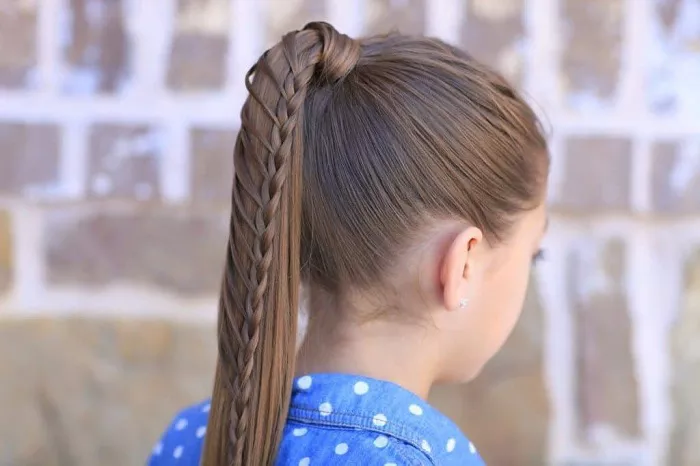Braiding a child’s hair can be a wonderful way to style it, but determining the right time to start braiding is crucial. It involves considering various factors related to the child’s hair health, age, and comfort. This article will explore these aspects in detail to provide a comprehensive guide on when it is appropriate to braid a child’s hair.
Hair Length and Thickness
Adequate Length
For simple braids like a single braid or pigtail braids, the child’s hair should generally be at least long enough to reach the nape of the neck. This length allows for enough hair to be gathered and braided without causing excessive tension on the scalp. If the hair is too short, attempting to braid can lead to pulling and discomfort. For more elaborate braids such as French braids or fishtail braids, the hair may need to be several inches longer, preferably shoulder – length or longer. This ensures that there is sufficient hair to work with and create the desired pattern.
Thickness Consideration
Thick hair can usually be braided earlier than very thin hair. Thick hair provides more volume and substance for the braid.
However, even with thick hair, it’s important to ensure that the braiding process doesn’t cause too much stress on the roots.
With thin hair, it might be better to wait until there is more hair growth to avoid creating weak or sparse – looking braids. If the child has thin hair, gentle braiding techniques and looser braids can be considered once the hair reaches an appropriate length.
Age of the Child
Toddler Years (1 – 3 years)
During the toddler years, it’s often best to be cautious with braiding. At this age, a child’s scalp is still very sensitive. Simple, loose braids can be attempted if the child has enough hair length, but they should be very gentle. Avoid tight braids as they can cause pain and may even lead to hair loss or damage to the delicate hair follicles. A single loose braid down the back or two very loose pigtail braids can be suitable for toddlers with longer hair. The focus should be on keeping the child comfortable and not restricting their movement.
Preschool Years (3 – 5 years)
As children enter the preschool years, they may be more willing to sit still for a short period during hair styling. At this age, more complex braiding styles can be introduced if the hair is of sufficient length. However, it’s still important to communicate with the child during the braiding process to ensure they are not in any discomfort. Styles like double braids or a simple braided crown can be fun options. The key is to make sure the braids are not too tight around the edges of the scalp, as this can cause headaches or irritate the skin.
School – Age Children (5 years and above)
Once a child starts school, they may have more specific preferences for their hairstyles. By this age, most children’s hair is usually long enough for a variety of braiding styles. They can handle more intricate braids like French braids or Dutch braids. However, it’s still essential to consider the child’s comfort during long school days. Braids should not be so tight that they cause pain or distraction during class. Also, make sure to check the scalp regularly for any signs of irritation or damage, especially if the child participates in physical activities during school breaks.
Hair Health and Condition
Clean and Tangle – Free Hair
Before braiding, the child’s hair should be clean and free of tangles. Tangled hair can make the braiding process more difficult and painful. Use a gentle, child – friendly shampoo and conditioner to keep the hair clean and soft. After washing, use a wide – tooth comb or a detangling brush to carefully remove any knots. Start from the ends of the hair and work your way up to the roots to avoid pulling and breaking the hair.
Hydrated Hair
Proper hydration is important for the hair’s elasticity. If the hair is dry, it is more prone to breakage during the braiding process. You can use a leave – in conditioner or a natural oil, such as coconut oil or argan oil, to keep the hair moisturized.
Apply a small amount of the product evenly through the hair, focusing on the mid – lengths and ends. This helps to make the hair more manageable and less likely to snap when being braided.
Activity Level of the Child
Active Play
If the child is very active and engages in a lot of running, jumping, and playing, it’s important to choose braiding styles that will stay in place without causing discomfort. Looser braids or styles that are secured well can be better options. For example, a braided ponytail can be a good choice as it keeps the hair out of the way during play while still allowing for some movement. Avoid styles that have loose strands that can get caught in the child’s face or cause distraction during playtime.
Sedentary Activities
For children who are more involved in sedentary activities like reading, drawing, or sitting in class, more elaborate and potentially slightly tighter braids can be considered. However, it’s still important to ensure that the braids do not cause any pain or restrict blood flow to the scalp. Styles like a braided headband or a more intricate French braid can be appropriate for these situations.
Conclusion
In conclusion, the decision of when to braid a child’s hair depends on multiple factors. By considering the length and thickness of the hair, the child’s age, the health of the hair, and the child’s activity level, parents and caregivers can make informed decisions to ensure that the braiding process is comfortable and safe for the child. This way, the child can enjoy beautiful and stylish braids without any negative impacts on their hair or well – being.

